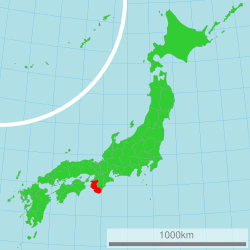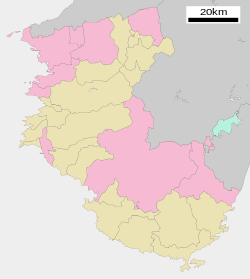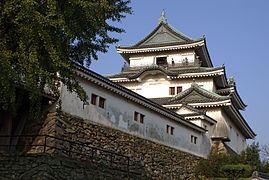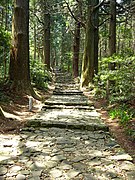Wakayama Prefecture
和歌山県 | |
|---|---|
| Japanese transcription(s) | |
| • Japanese | 和歌山県 |
| • Rōmaji | Wakayama-ken |
 Cherry blossoms bloom in the courtyard of Negoro-ji Temple in Iwade City, Wakayama Prefecture | |
| Anthem: Wakayama kenminka | |
 | |
| Country | Japan |
| Region | Kansai |
| Island | Honshū |
| Capital | Wakayama (city) |
| Subdivisions | Districts: 6, Municipalities: 30 |
| Government | |
| • Governor | Shūhei Kishimoto (since December 17, 2022) |
| Area | |
| • Total | 4,724.69 km2 (1,824.21 sq mi) |
| • Rank | 30th |
| Population (1 October 2017) | |
| • Total | 944,320 |
| • Rank | 39th |
| • Density | 199.87/km2 (517.7/sq mi) |
| • Dialects | Kishū |
| GDP | |
| • Total | JP¥ 3,745 billion US$ 34.4 billion (2019) |
| ISO 3166 code | JP-30 |
| Website | www.wakayama.lg.jp/ english/ |
| Symbols of Japan | |
| Bird | Japanese white-eye (Zosterops japonica) |
| Flower | Ume blossom (Prunus mume) |
| Tree | Ubame oak (Quercus phillyraeoides) |
Wakayama Prefecture (和歌山県, Wakayama-ken) is a prefecture of Japan located in the Kansai region of Honshu.[2]: 1026 Wakayama Prefecture has a population of 944,320 (as of 1 October 2017[update]) and has a geographic area of 4,724 square kilometres (1,824 sq mi). Wakayama Prefecture borders Osaka Prefecture to the north, and Mie Prefecture and Nara Prefecture to the northeast.
Wakayama is the capital and largest city of Wakayama Prefecture, with other major cities including Tanabe, Hashimoto, and Kinokawa.[3]: 1025 Wakayama Prefecture is located on the southwestern coast of the Kii Peninsula on the Kii Channel, connecting the Pacific Ocean and Seto Inland Sea, across from Tokushima Prefecture on the island of Shikoku.
History
[edit]Present-day Wakayama is mostly the western part of the province of Kii.[4]
1953 flood disaster
[edit]On July 17–18, 1953, a torrential heavy rain occurred, followed by collapse of levees, river flooding and landslides in a wide area. Many bridges and houses were destroyed. According to an officially confirmed report by the Government of Japan, 1,015 people died, with 5,709 injured and 7,115 houses lost.[citation needed]
Geography
[edit]
City Town Village
As of 31 March 2020, 13 percent of the total land area of the prefecture was designated as Natural Parks, namely the Setonaikai and Yoshino-Kumano National Parks; Kongō-Ikoma-Kisen and Kōya-Ryūjin Quasi-National Parks; and Enju Kaigan, Hatenashi Sanmyaku, Hikigawa, Jōgamori Hokodai, Kōyasanchō Ishimichi-Tamagawakyō, Kozagawa, Nishiarida, Oishi Kōgen, Ōtōsan, Ryūmonzan, Shiramisan-Wadagawakyō, and Shirasaki Kaigan Prefectural Natural Parks.[5]
Cities
[edit]Nine cities are in Wakayama Prefecture:
| Name | Area (km2) | Population | Map | |
|---|---|---|---|---|
| Rōmaji | Kanji | |||
| 有田市 | 36.91 | 27,963 | 
| |
| 御坊市 | 43.78 | 27,483 | 
| |
| 橋本市 | 130.31 | 62,941 | 
| |
| 岩出市 | 38.5 | 53,280 | 
| |
| 海南市 | 101.18 | 51,112 | 
| |
| 紀の川市 | 228.24 | 61,850 | 
| |
| 新宮市 | 255.43 | 26,815 | 
| |
| 田辺市 | 1,026.91 | 70,410 | 
| |
| 和歌山市 | 210.25 | 360,664 | 
| |
Towns and villages
[edit]These are the towns and villages in each district:
| Name | Area (km2) | Population | District | Type | Map | |
|---|---|---|---|---|---|---|
| Rōmaji | Kanji | |||||
| 有田川町 | 351.77 | 26,245 | Arida District | Town | 
| |
| 日高町 | 46.42 | 7,666 | Hidaka District | Town | 
| |
| 日高川町 | 331.61 | 9,615 | Hidaka District | Town | 
| |
| 広川町 | 65.35 | 7,059 | Arida District | Town | 
| |
| 印南町 | 113.63 | 7,949 | Hidaka District | Town | 
| |
| 上富田町 | 57.49 | 15,047 | Nishimuro District | Town | 
| |
| かつらぎ町 | 151.73 | 16,686 | Ito District | Town | 
| |
| 紀美野町 | 128.31 | 8,989 | Kaisō District | Town | 
| |
| 北山村 | 48.21 | 432 | Higashimuro District | Village | 
| |
| 高野町 | 137.08 | 3,279 | Ito District | Town | 
| |
| 古座川町 | 294.52 | 2,749 | Higashimuro District | Town | 
| |
| 九度山町 | 44.19 | 4,295 | Ito District | Town | 
| |
| 串本町 | 135.78 | 16,243 | Higashimuro District | Town | 
| |
| 美浜町 | 12.79 | 7,391 | Hidaka District | Town | 
| |
| みなべ町 | 120.26 | 12,561 | Hidaka District | Town | 
| |
| 那智勝浦町 | 183.45 | 17,261 | Higashimuro District | Town | 
| |
| 白浜町 | 201.04 | 23,325 | Nishimuro District | Town | 
| |
| すさみ町 | 174.71 | 4,011 | Nishimuro District | Town | 
| |
| 太地町 | 5.96 | 3,428 | Higashimuro District | Town | 
| |
| 湯浅町 | 20.8 | 11,960 | Arida District | Town | 
| |
| 由良町 | 30.74 | 5,738 | Hidaka District | Town | 
| |
Mergers
[edit]Demographics
[edit]
Since 1996, population of Wakayama Prefecture has kept declining, and since 2010, it has been the only prefecture in Kansai region with population below 1,000,000. In 2017, Wakayama is ranked 40th by population in Japan with a population of 944,320. In the 2020 census, close to 32% of the population was over 65 years of age - the highest percentage in Japan and one of the highest for national subdivisions worldwide.[6]
Politics
[edit]The current governor Shūhei Kishimoto was elected on 27 November 2022.[7]
Prefectural assembly
[edit]| Political party | Number of seats |
|---|---|
| Liberal Democratic Party | 28 |
| Reform Club (改新クラブ) | 5 |
| Komeito | 3 |
| Nippon Ishin no Kai | 3 |
| Japanese Communist Party | 1 |
| Independent society | 1 |
| Independent | 1 |
List of governors of Wakayama
[edit]State-appointed governors:
|
|
Publicly-elected governors:
|
|
Culture
[edit]Mount Kōya (高野山, Kōya-san) in the Ito District is the headquarters of the Shingon sect of Japanese Buddhism. It is home to one of the first Japanese style Buddhist temples in Japan and remains a pilgrimage site and an increasingly popular tourist destination as people flock to see its ancient temples set amidst the towering cedar trees at the top of the mountain. The Sacred sites and pilgrimage routes in the Kii Mountain Range extend for miles throughout the prefecture and together have been recognized as Japan's 11th UNESCO World Heritage Site.[9]
The Kumano Shrines are on the southern tip of the prefecture. Tomogashima (a cluster of four islands) is part of the prefecture.
Agriculture
[edit]Orange
[edit]Wakayama Prefecture ranks first in the production of oranges in Japan. Wakayama has its own brand of oranges, which is produced in Arida District and called 'Arida-Orange'. Arida District, where oranges have been produced for more than 400 years,[10] yields about half of the orange crops in Wakayama today.[11] Furthermore, the yield of Arida-Oranges accounts for about 10 percent of Japanese domestic production of oranges.[12]
Japanese apricot (Ume)
[edit]According to the survey by the Ministry of Agriculture, Forestry and Fisheries of Japan, Wakayama stands first in the production of Japanese apricots (梅, Ume) in Japan. As of 2016, Wakayama made up about 70 percent of Japanese domestic production of Japanese apricots.[13]
International relations
[edit]Wakayama Prefecture has friendship and sister relationships with six places outside Japan:[14]
 Florida, United States
Florida, United States Galicia, Spain
Galicia, Spain Pyrénées-Orientales, France
Pyrénées-Orientales, France Shandong, People's Republic of China
Shandong, People's Republic of China Sichuan, People's Republic of China
Sichuan, People's Republic of China Sinaloa, Mexico
Sinaloa, Mexico
Tourism
[edit]Wakayama Prefecture has hot springs such as Shirahama, Kawayu, and Yunomine Onsen.
-
Saikazaki, Wakanoura
-
The Museum of Modern Art, Wakayama
-
Konpon Daido
(Mount Kōya) -
Daimonzaka
(Kumano Kodō)
Transportation
[edit]Rail
[edit]- JR Central
- JR West
- Kishu Railway
- Nankai
- Wakayama Electric Railway
Road
[edit]Expressway
[edit]- Hanwa Expressway
- Keinawa Expressway
- Nachi Katsuura Road
- Yuasa Gobo Road
National Highway
[edit]- Route 24
- Route 26
- Route 42
- Route 168 (Shingu-Gojo-Ikoma-Hirakata)
- Route 169 (Shingu-Kumano-Kawakami-Yoshino-Asuka-Kashihara-Nara)
- Route 311 (Kamitonda-Tanabe-Shingu-kumano-Owase)
- Route 370 (Kainan-Hashimoto-Gojo-Uda-Nara)
- Route 371 (Kawachinagano-Hashimoto-Koya-Kushimoto)
- Route 424
Ferry
[edit]- Wakayama-Tokushima
Airport
[edit]Education
[edit]Universities
[edit]Notes
[edit]- ^ "2020年度国民経済計算(2015年基準・2008SNA) : 経済社会総合研究所 - 内閣府". 内閣府ホームページ (in Japanese). Retrieved 2023-05-18.
- ^ Nussbaum, Louis-Frédéric. (2005). "Wakayama prefecture" in Japan Encyclopedia, p. 1026, p. 1026, at Google Books; "Kansai" in p. 477, p. 477, at Google Books.
- ^ Nussbaum, "Wakayama" in p. 1025, p. 1025, at Google Books.
- ^ Nussbaum, "Provinces and prefectures" in p. 780, p. 780, at Google Books.
- ^ 自然公園都道府県別面積総括 [General overview of area figures for Natural Parks by prefecture] (PDF) (in Japanese). Ministry of the Environment. 31 March 2020. Retrieved 23 January 2020.
- ^ 2020 population census of Japan. https://www.stat.go.jp/english/data/kokusei/2020/summary.html
- ^ "Kishimoto Wins 1st Term as Governor of Japan's Wakayama Pref". 時事通信ニュース. 28 November 2022. Retrieved 26 July 2023.
- ^ "和歌山県議会会派名簿" [List of factions in the Wakayama Prefectural Assembly] (PDF). Wakayama Prefecture (in Japanese). 17 May 2023. Retrieved 26 July 2023.
- ^ UNESCO.org
- ^ 今月の旬 Wakayama Prefecture website, accessed May 31, 2017
- ^ 農林水産 特産品 Wakayama Prefecture website, accessed May 31, 2017
- ^ 有田みかんについて JA Arida website, accessed May 31, 2017
- ^ 作況調査(果樹): 農林水産省 The Ministry of Agriculture, Forestry and Fisheries website, accessed June 1, 2017
- ^ 友好・姉妹提携 Archived 2011-06-11 at the Wayback Machine Wakayama Prefecture website, retrieved May 16, 2008
References
[edit]- Nussbaum, Louis-Frédéric and Käthe Roth. (2005). Japan encyclopedia. Cambridge: Harvard University Press. ISBN 978-0-674-01753-5; OCLC 58053128











